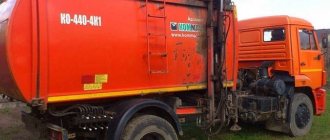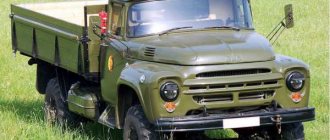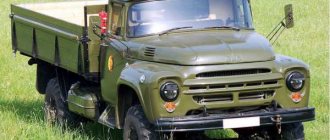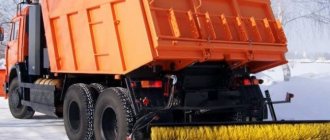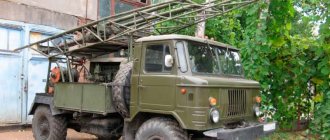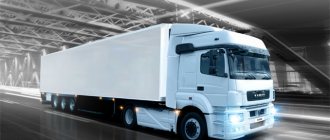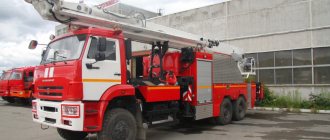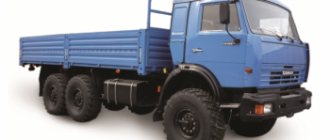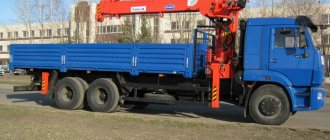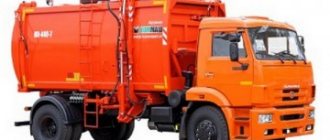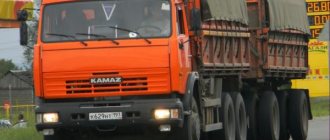When using equipment, you can often encounter significant downtime, which to a certain extent can be explained by seasonality. This phenomenon does not bring profit, and as for the costs of such equipment, no one can cancel them. Today, a similar problem is proposed to be solved in some ways, for example, by equipping the equipment with a multi-lift body installation system. Note that in this case, the capabilities of the equipment will automatically expand, it will be possible to operate it regardless of the season, that is, now temporary downtime can be completely eliminated. Equipment equipped with such a system is in great demand, the benefits of its availability are especially noticeable in companies where they regularly have to transport scrap metal and other solid household waste. Such vehicles are capable of working not only with bodies, but also with containers, regardless of their main functional purpose.
KAMAZ hook lifts
For various versions of the Kama Automobile Plant chassis, hook systems are supplied by various manufacturers, in particular, Velikoluksky Machine-Building Plant and the Dutch company Hyva.
Purpose
The main idea in using such a loading and unloading system is to make the vehicle chassis universal, capable of transporting various types of bodies, including:
- Bunkers for transporting bulk materials, including agricultural crops, solid waste, construction waste, wood chips, etc.
- Containers.
- Change houses, mobile residential buildings, etc. modules.
- Tanks.
- Possibility of working with a trailer.
Multilifts are widely used in the armed forces, from where, in fact, they came into civilian use.
Advantages and disadvantages
In addition to reducing the vehicle fleet due to the versatility of using vehicles equipped with a hook lift, several more problems are solved:
- Vehicle downtime is reduced to a minimum.
- The chassis can work with different bodies, and the bodies can be used by different vehicles equipped with such a system.
- Technological downtime for loading and unloading operations is reduced to 3 minutes.
- High maneuverability, the ability to unload or load in conditions of limited space, including unloading in a “dump” manner.
- Possibility of working with a trailer.
At the same time, the design is simple, reliable and easy to maintain; manipulations with the bodies do not require the driver to leave the workplace. Unlike the cable loading system, the hook system secures the body on the vehicle at three points, which ensures the rigidity of the load on the vehicle and allows for increased transport speed.
One of the disadvantages is the weight of the system, which you always have to carry with you. The kinematics of the manipulator’s operation imposes certain restrictions on both the length of the platform where the body is installed and the height, limiting its use in tunnels and buildings with a low arch.
The tilt angle of the body during unloading usually does not exceed 50°.
"Multilift" vs Dump Truck (Part 3)
(Continuation, beginning, see “OS” No. 2, 4, 2013)
What could be simpler than a dump truck with a hydraulic cylinder in front of the body? No special subframes or clever designs for you, just a movable connection to the frame on hinges. The obvious advantages of such a device are a low center of gravity, the absence of excess “ballast” mass that eats up excess fuel, and a relatively low price. This type of dump truck does not require a powerful hydraulic system, because the large force application lever makes life much easier for the hydraulic cylinder. Accordingly, high engine power is not needed here, and it is no coincidence that the first domestic and foreign dump trucks were built on this principle. This system has not outlived its usefulness today, despite the fact that the issue of power for both diesel and hydraulic engines is not as pressing as before. Our most popular dump trucks on the KamAZ chassis are still designed this way. However, the industry is developing, and not always in the direction that buyers of its products would like. Businesses are choosing to keep things simple and cheap, and as a result we have to put up with disgusting plastic masks simply because it's faster and cheaper to produce them. Now that there is no shortage of powerful hydraulic systems, manufacturers are tempted by the desire to save on components. A simple comparison: if the hydraulic cylinder is located in front of the lifting body, then it consists of five or six telescopic mirrors, and this is on a three-axle vehicle, what can we say about 4-axle chassis and trailers! If you arrange the dump truck with the cylinder stop closer to the attachment points, one or two will be enough. There is enough power for lifting, and the cost of the machine is lower. Of course, the disadvantages cannot be avoided with such a design: the equipment cannot be placed in the frame clearance, transverse reinforcements will not be provided, you have to build a subframe, and this means an increase in the empty mass and center of gravity, and a complication of the entire structure with additional elements. And such dump trucks spend more time lifting the body. A dump truck on a “sled” is more difficult to “connect” to heating the bottom with exhaust gases simply because the body is higher, but this point is not always relevant even for our generally cold country. And depending on the temperature, heating may not prevent, but on the contrary, promote freezing of the soil to the bottom. Well, when removing snow flavored with sand and salt reagents, heating the body will lead to the fact that all the “snow maidens” will melt along the road, there will be nothing to unload! And the harsh eco-standards that are inexorably advancing for everyone except aircraft prevent the body from being heated by exhaust gases, because exhaust systems are becoming more and more complex, and those exhaust gases that ultimately leave the pipe after all the “afterburning”, filtration and recirculation are deprived of temperature, sufficient to warm up the steel bottom. So it’s time to look for another way to prevent sticking, this could be an oval body shape (half-pipe) or special polymer coatings on the walls and bottom, which not only improve the alignment of the material, but also additionally protect the metal from corrosion.
See what happens next, after the body is no longer directly connected to the frame, but rests on a special lifting platform. A simple question arises: how to fasten it - “permanently” with bolts or use quick-release methods? The system of dragging a body using a winch arose at the dawn of the automobile era. Rolling, as you know, is easier than lifting. Before the invention of the Euro pallet, all goods were rolled in barrels on platforms. So it is with the cable loading method, which for brevity we call “cable multilift”, and in the English-speaking environment it is known as Roll-Off, roughly translated as “twist and drop”. The replacement body is rolled onto the platform using a winch; this process is carried out by alternating between pulling the cable and lifting the platform. The body is also placed back on the ground, only in this case the winch cable is released one by one and the platform is lowered. Cable “multilifts” are similar in the Old and New Worlds, only in Europe it is customary to spin a reel with two cables, while in the States they are content with one. It is difficult to say in which case operation is safer; if in a system with two cables one breaks, the second will probably experience the same from the sharply increased load, but lifting with two cables can be considered more convenient, since the body is more accurately placed on the guides. Drivers, of course, have more work to do: attach two hooks instead of one, but in Russia, which adopts mainly European technologies, they are not as spoiled as in the USA.
Unfortunately, in the Soviet Union they did not accept the economic efficiency of exchangeable bodies; at that time they were more keen on the idea of exchangeable semi-trailers, but even in those conditions when there was essentially only one owner - the state, its “effective managers” were unable to coordinate their work in such a way , in order to at least avoid losses - what kind of profit is there? On the other hand, where in the Union could replaceable bunkers find use? Fallen leaves and branches along with candy wrappers were burned at spring cleanup days right in the courtyards, scrap metal was collected by schoolchildren, and multi-story buildings had not yet been demolished. Well, the speed of loading and unloading, the degree of involvement of all units of rolling stock, cost reduction - for the Soviet economy these were empty words. In the absence of a free market, only the military could evaluate quick release systems, which they did then and continue to do today. True, at present the interest of the Armed Forces has noticeably shifted towards another structural system - a hydraulic hook loader, called hook-lift in English. And it’s not surprising: loading and unloading is carried out here faster than with a cable mechanism, the driver does not need to leave the cab, and the power of modern “multi-lifts” allows you to “drop” not only supplies, but also an entire infantry fighting vehicle with troops into the combat zone. Having unloaded in a minute, the carrier will have time to leave the line of fire even before the sights are pointed at him. Even in war conditions, large losses of equipment are obvious, so universal vehicles for the army are always at a premium.
But in peacetime, not everything is as simple as at the front. Who would want to give their replacement body to the enemy: a competitor or a black “metal worker”? Meanwhile, abandoned unattended, a huge piece of good steel with a hook loop and rollers will go to another region that same night. European cubic containers often disappear, as they say, “to the dacha,” but here is a whole body: if you pick it up with a suitable car, no one will be surprised that they take it away incompletely. In addition to criminal issues, the development of quick-release systems is hampered in our country by the elementary poverty of private entrepreneurs, organizations and other business entities. If they are engaged in the transportation of bulk cargo, then the opportunity to change the body is beneficial only from the point of view of chassis occupancy, that is, if there is a backlog of orders, a nimble private owner in one “multi-lift” car with two or even three bodies will plow from morning to night, until the road inspection will not force him into a “black box” so that he complies with the technical specifications, safety regulations, etc. But if there is no work and the guy on his dump truck is bored for days, annoying dispatchers on the phone, what benefit will a hook or cable give him? The only thing is that loading can be done by placing the body on the ground. But in this case, he will again choose one body, as those who buy cars with a multi-lift system in Russia today often do. The only hope lies with large operators working in the field of scrap and waste removal, since they can afford to purchase several bodies on one chassis, and containers are installed mainly in protected industrial areas, and the economic efficiency of the circulation of bunkers is obvious to them.
The cable “multilift” has somehow naturally been assigned work in the public utilities sector, while its hook analogue is used much more widely in Europe, inventing a huge number of replaceable superstructures for it, which, even if you want, cannot be called bodies. This replaceable equipment gives us the same versatility of the “multi-lift”, but, returning to the topic of conversation, who will replace whom, we can agree that a bucket truck, a change house and a kocher for cast asphalt concrete will replace the dump truck. Here any normal foreman, without hesitation, will twist his head and say: “What are you talking about?” So the main Russian supplier of chassis for municipal vehicles, KamAZ OJSC, found a place for all variants of “multi-lifts” in the “dump trucks” section, and there was no confusion. Of course, our car factories partly benefit from such a very narrow perception of the “multi-lift” as just a variant of a car with a tipper unloading; after all, it is more important for them to sell the chassis, not the body, and here journalists and marketers are vying with each other to shout that these same chassis will be able to be bought less! And this is called manufacturer support? So take the “multi-lift” on our chassis with one body and don’t think about changing it at all. Whether it’s a joke or not, often a carrier from us buys a truck with a multi-lift system only to assemble a garbage truck from it, installing an additional crane and attaching a press compactor of a suitable size with a hook. The machine will carry this container on itself forever, like a snail’s shell, never removing it. Clearly, the question arises: why fence the garden, spend money on the extra weight of the hook installation, if there is no need to remove the equipment? Wouldn't it be easier to assemble such a garbage truck from a serial one with a side (top) loading, adding a CMU to it? It seems simpler, only our factories are traditionally inert, and easy-going foreign “capitalists” have overwhelmed our public utilities with their tempting offers “on the combination of price and quality.” But this is not only the fault of the factories, but of the entire Ministry of Automotive Industry (or whatever they have now), how much time is spent on bureaucratic delays with certification, changed MPR-1 to MPR-2, run and get OTTS for a new car. One way out: put the entire garbage truck body with a crane and the rest of the hydraulics on a “multi-lift” sled at once!
But despite all the ups and downs, replacement equipment is gradually gaining popularity, albeit for now mainly in the segment of industrial and household waste removal. At the same time, greater success is clearly noticeable with the “hook-lift” than with the “rope-lift” (let’s support the movement for the purity of the Russian language). Although from the point of view of the driver-operator it is not so easy to operate, even if you do not have to leave the cab. Compare the control panels for both systems: the “cable lift” has only two switches - for the platform and for the winch, they have two positions: up and down. What about the “hook-lift”? A whole joystick for moving the handle, plus the movements of the hook itself, and even the locks... Maybe not the “picket fence” of levers on the grader, but still go figure it out. The hook loader is a relatively young invention of human engineering, but it has already formed two design schools. The difference is in the hook drive. One idea is to telescope it, the other has a folding hook, or rather an inclined one, controlled by a hydraulic cylinder. In the first case, the installation is more expensive, but its own weight is lower. In countries where they know how to value every kilogram of a car's dry weight, this matters. It is profitable to spend more today, but to win in the future. That is why the hooks of European brands are entirely telescopic. From domestic manufacturers you can often find a folding hook, this is due not only to the other culture of our people, about which the saying goes: the miser pays twice. Our buyer understands this whole perspective no worse than the locals, but in the price list he looks for something that costs less, that’s the whole trick. Compare for example: Runet sites by default sort goods by price, and foreign ones - by newness. And after that, it no longer matters where the crisis begins, the important thing is where it will never end! But from an unbiased technical point of view, both versions of hook systems work flawlessly, and the geometry of body movement during loading and unloading is not very different between them. The inclined hook is forced to lift the container in the final stage of “landing” on the frame, while the telescopic “drags” it in a straight line until it stops, but this is not important. The assumption that this or that design will be less reliable is unfounded, since even a schoolchild knows that quality does not depend on the drawing or brand, but on whether the production technology is followed, whether the operation is carried out correctly and maintenance is carried out in a timely manner. As for the hydraulic drive of the moving platform, for both the hook and cable systems it is carried out by a pair of symmetrically located single-rod double-acting cylinders. In “cable elevators” they rest either in the middle or closer to the base of the platform, in “hook elevators” - at the junction of the elevator column on which the hook is located with the lifting platform. The design principle of cable loaders also includes such an “ace in the hole” as the ability to unload the contents of the body into large containers standing on the ground, so to speak, “toss the garbage over the fence.” To do this, the platform is made double, additional cylinders are installed, and when it all rises together, the profile of the platform together with the frame resembles the Latin letter Z. It is clear that this both increases the cost and increases the ballast mass, but organizations that transport waste in small containers on a chassis medium-tonnage trucks save on the fact that, after reloading them into large bunkers, they are sent on a long trip to processing or to a landfill in one high-capacity vehicle with a trailer.
What really unites the four types of dump trucks listed is the direction in which they unload, this time not in a figurative sense, but in a literal sense, that is, they unload backwards. According to this criterion, a dump truck with three-way unloading stands apart from everyone else, also a universal special vehicle of its kind, which certainly cannot be replaced by any “multi-lift” simply because the functions of the vehicles are too different. It should be noted that we didn’t really like them. Their design is quite simple, only the hydraulic cylinder is located not in front of the body, but exactly in the middle of it. But there are not two loops, but six, on removable “fingers,” and in order to unload, you first have to crawl out into the mud, pull on the mittens, pull out the ones you need, leaving in place only those on which side you were going to unload. What happens if you confuse right and left, you don’t have to add it... It’s not enough, you also have to open the side manually. “Multilateral” dump trucks in our country have gained the reputation of being purely agricultural machines, and it was completely in vain. Well, let’s say, still in the segment of large-tonnage chassis, but among medium-tonnage trucks only such dump trucks should be used; unloading on the side, by the way, is a solution for all kinds of construction sites where there is little free space and nowhere to turn around. If versatility is more important and unloading only to the rear is sufficient, you should choose a “multilift”. You can start a business with one body, and when the need arises, expand the business; it will be much easier to buy a second replacement body than a second (or even another) truck.
Device
Structurally, the hook multi-lift system is an L-shaped frame, on the short arm of which there is a hook. With its help, a replacement body located on the ground or a trailer is grabbed by the eye located at its end end and dragged onto the vehicle.
KamAZ trucks with the multi-leaf system have several modifications:
- MPR-1 (MPR-14P.45). System with a lifting capacity of 14 tons with a fixed length frame and a rotating hook beam driven by a hydraulic cylinder and mounted on hinges.
- MPR-2 (MPR-18T.52). Unlike the previous one, the frame became telescopic, which made it possible to increase its length and use larger bodies. Load capacity – 18 tons.
- MPR-3 (MPR-20P.58). A 20-ton mechanism in which the frame is made folding.
Hyva manipulators use a telescopic frame. The company supplies its equipment for installation on a 4-axle KAMAZ chassis and has a load capacity of 26 tons.
KamAZ multi-lift with trailer - functional purpose
The main idea of implementing such a solution is to give the car chassis versatility, due to which, after implementation, the car acquires the ability to transport various body options, namely:
- Containers of various types;
- Tanks, other types of containers;
- Mobile homes, change houses, other options for modular systems;
- Bunkers designed for the transportation of solid materials (bulk, piece).
Such equipment can work not only as an independent unit, but also in conjunction with a trailer, thereby significantly increasing its productivity and efficiency. Multilifts are extremely popular in the armed forces, but today a similar solution, due to its many advantages, is also found in the civilian sector.
Specifications
The loading and unloading system used determines the chassis that is suitable for use with this particular modification of the multilift. Shortened chassis are suitable for MPR-1, in particular, 2-axle 43253, short versions of chassis 65115.
MPR-2 allows the use of longer vehicles, for example, chassis 65115-1095, providing the use of longer swap bodies with greater load capacity.
Based on the 6520 chassis, it is used to install multilifts produced by Velmash and Hyva. The maximum lifting capacity is 20 tons.
The four-axle KAMAZ 65201 chassis is used for use with the Hyva lifting system itself. It allows the use of the most capacious bodies with a maximum cargo weight of up to 26 tons.
Models with lifting capacity up to 20 tons
Technical characteristics table. 1:
| Model | AS-9 | AS-10 |
| Loading and unloading equipment | MPR-1 (MPR-14P.45) | MPR-1 (MPR-14P.45) |
| Chassis | 43253-N3 (-A3) | 43118-10 (-15, -24) |
| Towbar | — | — |
| Engine | Cummins 6ISBe210, 6ISDe210, 4ISBe185, 4ISDe185 | 740.30-260 (31-240, 55-300) |
| Power, hp (kW) | 210 (154)/185 (133) | 260(180)/240 (177)/300 (221) |
| checkpoint | KAMAZ-142, 144, 152, ZF-6S | KAMAZ-154 (142, 144, 152, ZF-9S) |
| Wheel formula | 4x2 | 6x6 |
| Load capacity, kg | 14 000 | 14 000 |
| Max. container volume, m3 | 20 | 20 |
| Climbing angle, degrees | 50 | 50 |
| Dimensions, LxWxH | 7415x2500x3630 | 8540x2500x 3850 |
| Curb weight, kg | 7960 | 11030 |
In the video, the MPR-1 multilift based on KamAZ 65115:
Technical characteristics table. 2:
| Model | AS-14 | AS-15 | AS-20V |
| Loading and unloading equipment | MPR-1 (MPR-14P.45) | MPR-2 (MPR-18T.52) | MPR-2 (MPR-18T.52) |
| Chassis | 65115-1041-62(-65, D3) | 65115-1095-62 (-65, D3) | 6520-1072-60 / 61 |
| Towbar | — | — | + |
| Engine | 740.30-280 | 740.30-280 | 740.60-360 / 61-320 |
| Power, hp (kW) | 280 (206) | 280 (206) | 360 (265) )/ 320 (235) |
| checkpoint | KAMAZ-154 | KAMAZ-154 | ZF-16S151 |
| Wheel formula | 6x4 | 6x4 | 6x4 |
| Load capacity, kg | 14 000 | 18000 | 18000 |
| Max. container volume, m3 | 27 | 30 | 30 |
| Climbing angle, degrees | 50 | 50 | 50 |
| Dimensions, LxWxH | 7630x2500x3100 | 8550x2500x3100 | 8650x2500x3270 |
| Curb weight, kg | 10010 | 10950 | 1350 |
Photo of multilift AS-15
Machines with a lifting capacity of 20 tons
Technical characteristics table 1:
| Model | AS-20 | AS-20K | AS-20D |
| Loading and unloading equipment | HYVA Technamics 20-51-S | HYVATechnamics 20-47-S | HYVA Technamics 20-58-S |
| Chassis | 6520-1072-60 | 6520-1072-60 | 6520-1072-60 |
| Towbar | + | + | + |
| Engine | 740.60-360 | 740.60-360 | 740.60-360 |
| Power, hp (kW) | 360 (265) | 360 (265) | 360 (265) |
| checkpoint | ZF-16S151 | ZF-16S151 | ZF-16S151 |
| Wheel formula | 6x4 | 6x4 | 6x4 |
| Load capacity, kg | 20000 | 20000 | 20000 |
| Max. container volume, m3 | 36 | 30 | 36 |
| Climbing angle, degrees | 48 | 53 | 47 |
| Dimensions, LxWxH | 9479x2500x3060 | 9080x2500x3050 | 9479x2500x3060 |
| Weight of equipment, kg | 12000 | 12750 | 12350 |
| Total weight, kg | 33050 | 33050 | 33000 |
Photo of multilift AS-20D Technical characteristics table 2:
| Model | AS-22 | AS-26 |
| Loading and unloading equipment | MPR-3 (MPR-20P.58) | HYVA Technamics 26-62-S |
| Chassis | 6520-1072-60 | KAMAZ 65201-60 |
| Towbar | + | — |
| Engine | 740.60-360 | 740.60-360 |
| Power, hp (kW) | 360 (265) | 360 (265) |
| checkpoint | ZF-16S151 | ZF-16S151 |
| Wheel formula | 6x4 | 8x4 |
| Load capacity, kg | 20000 | 26000 |
| Max. container volume, m3 | 35 | 38 |
| Climbing angle, degrees | 48 | 49 |
| Dimensions, LxWxH | 8840x2500x3270 | 9080x2500x3050 |
| Weight of equipment, kg | 12850 | 13500 |
| Total weight, kg | 33000 | 39500 |
Photo of KamAZ AS-22 multilift
Features and benefits of KamAZ multi-lift with trailer
Due to the versatility of the proposed solution, it is possible to slightly reduce the vehicle fleet, which will reduce the cost of its maintenance. This type of technology allows you to effectively solve the following problems:
- Equipment equipped with such a system is capable of working with various bodies;
- The downtime of road transport is minimal in time, which has a positive effect on the productivity of the equipment;
- Mobility, maneuverability, which allows loading/unloading activities in confined spaces;
- The time for unloading and loading work is reduced on average by 3-5 minutes;
- The equipment can work with a trailer, the reliability and quality of cargo transportation is guaranteed.
The advantageous advantage of this system is its reliability, high quality, and ease of maintenance. All manipulations are performed by the driver from the cab; no outside assistance is required. After installing the body on the frame, it is fixed at three points, which ensures maximum safety and reliability during cargo transportation. The only important thing to note is that such a system has a decent weight, which is why fuel consumption increases slightly even at idle. When the body is tipped over at the time of unloading, the tilt angle is 50 degrees.
